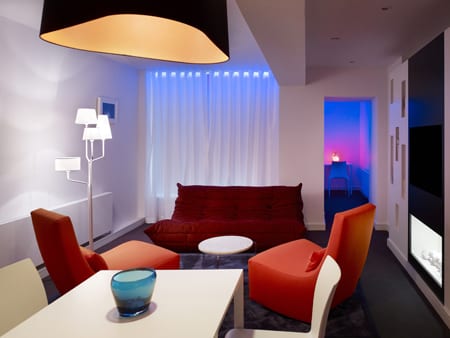
Photography by Undine Pröhl and Adrien Dirand
For their seventh hotel, Habita Monterrey, the partners behind stylish Mexican boutique hotel company Grupo Habita looked across the pond for inspiration. "We wanted to give some European spirit to this hotel. We are fans of French interior design but what we found in Monterrey was mainly of American influence," explains Carlos Couturier, the brand’s managing partner, adding that they picked the mountainous Mexican city for its close proximity to the U.S. and its wealthy demographic.
After interviewing more than 15 designers in Paris, the foursome took a chance on an unlikely source—neophyte hotel designer Joseph Dirand. "We broke the established rules in terms of how to build a hotel," Couturier says, noting that they admired his residential and retail spaces’ retro industrial aesthetic. "We chose a contemporary architect [locally based Agustín Landa] and a French interior designer in a city ruled by old traditions."

And the duo delivered. Landa’s mid-century inspired curvilinear, geometric eight-story building of concrete, steel, and glass (Monterrey is one of the global leaders in the manufacturing of those three materials) hints to Dirand’s minimalist, dramatic, yet inviting design inside. "For me a hotel is about making people live a new experience," Dirand says. "Inspiration came naturally from the landscape, the climate, and the way people live in this city. The hotel is a progression through different spaces—from shadow and darkness to light."
Concrete prevails in the monastery-like, sculptural lobby and on the rooftop terrace complete with 360-degree views and two flanking symmetric infinity pools. Elsewhere, expanses of black and white "shape the spaces and create a rhythm in the architecture," Dirand says. In the 39 airy guestrooms, floors, walls, and ceilings are painted white, wood furniture is stained black, and bathrooms are done in marble and onyx. Even the black corridors end at white spaces where the doors recess.

Thoughtful details supplement the architectural experience. A white cowskin carpet in the lobby and skulls in the restaurant nod to the area’s hunting history; black and white vintage furniture mostly from the 1950s and ’60s (think Arne Jacobsen, Harry Bertoia) add rounded shapes in the otherwise clean-lined spaces; and in the restaurant and lobby, a mosaic of curved mirrors normally used for palaces in India cover an accent wall. "I try to redefine the codes of luxury in mixing rough and sophisticated spaces and elements," says Dirand, who just completed Grupo Habita’s Distrito Capital hotel in Mexico City last month. "Those mirrors become almost an abstract texture that react different with the daylight and night light."

The biggest challenge? Keeping the international team "on the same orbit," says Couturier, noting that the project took four years to complete. "We had a Portuguese architect based in Monterrey working for Landa, a French interior designer, music proposition from London, and a very talented Mexican chef."
Habita Monterrey (Habita MTY)
Monterrey, Mexico
Owner: Martell
Operator: Grupo Habita
Architecture Firm: Landa Arquitectos,Monterrey, Mexico
Architecture Project Team: Agustin Landa
Interior Design Firm: Joseph Dirand,Paris
Graphics: Cadena + Asoc.
Music: Xavier Artus
Vintage Pieces: Claudia Fernandez
Restaurant
Chairs: Cappellini
Tables Designed by Joseph Dirand; manufactured by Ezequiel Farca
Fabrics: Dominique Kieffer and Rubelli
Bar
Chairs: Fritz Hansen
Lamps: Serge Mouille
Business Center
Tables: Designed by Joseph Dirand; manufactured by Ezequiel Farca
Chairs: Cappellini and Fritz Hansen
Books: Habita Books
Lobby
Furniture: Rick Owens
Terrace
Tables: Ascete
Chairs: Knoll
Guestrooms
Chairs: Cappellini
Tables: Designed by Joseph Dirand; manufactured by Ezequiel Farca
Clocks: Mondaine
Telephones: Bang & Olufsen
Amenities: Aesop
Lamps: Serge Mouille
Suites
Chairs: Fritz Hansen


